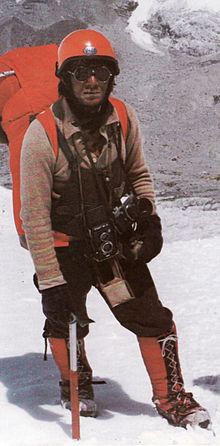Jerzy Kukuczka
Jerzy Kukuczka | |
|---|---|
 Jerzy Kukuczka on Mount Everest, 1980 | |
| Born | 24 March 1948 |
| Died | 24 October 1989 (aged 41) |
| Occupation | Mountaineer |

Jerzy Kukuczka (24 March 1948 in Katowice, Poland – 24 October 1989 Lhotse, Nepal) was a Polish alpine and high-altitude climber. Born in Katowice, his family origin is Goral. On 18 September 1987, he became the second man (after Reinhold Messner), to climb all fourteen eight-thousanders in the world. As the only man in the world has won two eight-thousanders in one winter, a total winter won four eight-thousanders, including three for the first time in the winter. Along with Tadeusz Piotrowski, Kukuczka established a new route on K2 in alpine style (the so-called "Polish Line"), which no one has ever repeated.
Eight-thousanders
Kukuczka is widely considered among the climbing community to be one of the best high-altitude climbers in history.[1] He ascended all fourteen eight-thousanders in just seven years, 11 months and 14 days - He held the world record for shortest time span to summit the eight-thousanders for nearly 27 years until May 2014 when Kim Chang-ho beat his mark by one month and eight days.[2] During his career, Kukuczka established ten new routes (still unbeaten record) and climbed four summits in winter. He was one of an elite group of Polish Himalayan mountaineers who specialized in winter ascents (called Ice Warriors).
| Year | Location | Mountain | Route | Comments |
|---|---|---|---|---|
| 1979 | Nepal | Lhotse | West Face | Normal Route |
| 1980 | Nepal | Mount Everest | South Pillar | New Route |
| 1981 | Nepal | Makalu | Variation to Makalu La/North-West Ridge | New Route, Alpine Style, Solo. |
| 1982 | Pakistan | Broad Peak | West Spur | Normal Route, Alpine Style. |
| 1983 | Pakistan | Gasherbrum II | South-East Spur | New Route, Alpine Style. |
| 1983 | Pakistan | Gasherbrum I | South-West Face | New Route, Alpine Style. |
| 1984 | Pakistan | Broad Peak | Traverse of North, Middle, Rocky and Main Summits | New Route, Alpine Style. |
| 1985 | Nepal | Dhaulagiri | North-East Spur | Normal Route, First Winter Ascent.[3] |
| 1985 | Nepal | Cho Oyu | South-East Pillar | Second Winter Ascent |
| 1985 | Pakistan | Nanga Parbat | South-East Pillar | New Route. |
| 1986 | Nepal | Kanchenjunga | South-West Face | Normal Route, First Winter Ascent. |
| 1986 | Pakistan | K2 | South Face | New Route, Alpine Style. |
| 1986 | Nepal | Manaslu | North-East Face | New Route, Alpine Style. |
| 1987 | Nepal | Annapurna I | North Face | Normal Route, First Winter Ascent. |
| 1987 | China | Shishapangma | West Ridge | New Route, Alpine Style, Ski Descent. |
| 1988 | Nepal | Annapurna East | South Face | New Route, Alpine Style. |
He climbed all summits, except for Mount Everest, without the use of supplemental oxygen.
Death
Kukuczka died attempting to climb the unclimbed South Face of Lhotse in Nepal on 24 October 1989. He was leading a pitch at an altitude of about 8,200 meters on a 6 mm secondhand rope he had picked up in a market in Kathmandu (according to Ryszard Pawłowski, Kukuczka's climbing partner on the tragic day, the main single rope used by the team was too jammed to be used and the climbers decided to use transport rope instead). When he lost his footing and fell, the cord was either cut or snapped from the fall, plunging Kukuczka ~2000 meters to his death.
-
Jerzy Kukuczka's memorial with Lhotse in the background
-
Memorial plaque in Istebna
-
Monument of Polish mountaineers in Katowice
See also
Bibliography
- Kukuczka, Jerzy (1992). My Vertical World: Climbing the 8000-Metre Peaks. Mountaineers Books. p. 189pp. ISBN 0-89886-344-9.
- Wąsikowski, Piotr (1996). Dwa razy Everest. PiT.
- Kukuczka, Jerzy (1990). Na szczytach swiata. Krajowa Agencja Wydawnicza. p. 193pp. ISBN 83-03-03166-X.
External links
- Everest History: Jerzy "Jurek" Kukuczka
- Poland.gov.pl: The Crown of the Himalayas
- The legend: 5 stars out of 5
- Jerzy Kukuczka, il trailer del nuovo film (Italian)
- WinterClimb.com: Jerzy Kukuczka - short biography and list of ascents
References
- ^ Doubrawa-Cochlin, Ingeborga. "A Tribute to Jerzy Kukuczka (1948- 1989)". The Alpine Journal: 32–34. ISSN 0065-6569.
- ^ Korean Everest Sea to Summit marred by tragedy
- ^ Xexplorers web:The meaning of winter in 8000+ climbing



